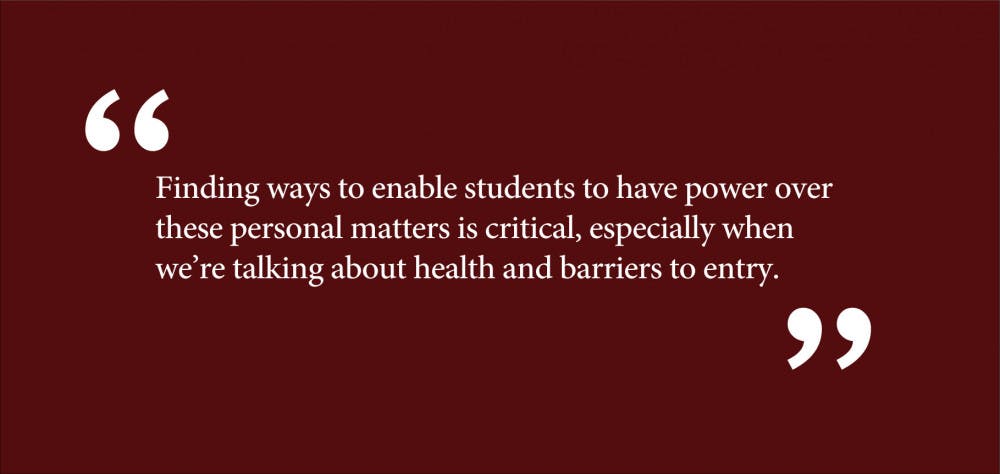I got my flu shot last week. The whole process was fast, convenient and entirely free — in fact, the most difficult part for a brand new student was finding the basement lounge where the shots were being administered. Encouraging the student body to inoculate against the onset of flu season is an admirable goal, but the ease of this process stood in stark contrast to my other experience with vaccinations at Brown. Rather, registering the rest of my existing immunizations with the University was disorganized, complex and costly.
Brown, and the state of Rhode Island, require a set of immunizations of all incoming students, graduate and undergraduate alike. Despite this standard, the process of proving compliance with this requirement is expensive, outdated and not fully communicated to students. This poses problems and potential barriers to entry for students — the costs associated with proving compliance can be significant in medical bills but also in time off from work and transportation. Worse than the substantial cost of this part of the onboarding process is the fact that alternatives exist that are not communicated to students.
I’d like to illustrate with my own experience. The immunization record form required by the University must be filled out and signed by a physician or medical provider. Before any doctor would sign my form, they required an intake physical. Because I was interning out-of-state, none of these non-emergency medical procedures were covered under my health insurance, meaning that I was paying entirely out-of-pocket for a physical, lab work, transportation and missed internship work.
Incoming students are informed that immunization records are due by July 1 the summer before they arrive. It was mid-way through June and I was more than $500 in debt from the process when I realized that I still needed a second dose of the varicella vaccine — the chicken pox shot — which would add close to another $200 to my debt. I was not in compliance and didn’t have the money to afford the final vaccination. Even though my graduate program at Brown has provided a sizable stipend, covering my tuition and health insurance, I wasn’t going to be able to afford to even get to Brown.
Out of desperation, I emailed Health Services to see if there was any sort of fellowship or scholarship they could provide to cover medical expenses necessary to get to Brown. I was informed by the nursing staff that I could ignore the July 1 deadline, come to Brown not in compliance and get my final vaccination covered by my insurance from Health Services.
The cost of preparing my immunization record was nearly prohibitive, only affordable because it turns out I didn’t need it. I came to Brown while not in compliance, got my health insurance here, then received my final varicella vaccination for free. If this option had been communicated to me, I would have saved a substantial amount of money. Five hundred dollars may not seem like much, but it was the difference between paid and unpaid credit card bills and determined whether I could buy any of my textbooks at the beginning of the semester.
So how do we fix this? Accept more forms of vaccination verification rather than just the established form; records faxed from doctor’s offices should be sufficient. Regardless of whether health staff here evaluate them and determine compliance, or whether a different doctor fulfills the same task, the result is the same. An increase in communication is imperative as well — is it okay to come to Brown while non-compliant? Let your students know. And affording immunization records isn’t the only onboarding cost awaiting new students — their future holds internet setup costs, textbook rentals and, in the case of graduate students like me, trying to afford food when stipend payouts don’t come until the end of the first month.
Finding ways to enable students to have power over these personal matters is critical, especially when we’re talking about health and barriers to entry. Even with good funding and covered health care, the cost of entrance into school can be prohibitive, and the way to make it possible could just be a matter of actively sharing information with students.
Vaccinations are important, and they should be required. To that end, Brown should make it as easy as possible to ensure that its student body is protected. And that doesn’t always mean coming in with a signed immunization form. Because while my situation may have been unique, every student who comes here faces their own, often pricey, obstacles. Awareness of these hidden costs, and steps to mitigate them, will ultimately ensure a healthier and more accessible campus environment.
E.L. Meszaros GS can be reached at e.l.meszaros@brown.edu. Please send responses to this opinion to letters@browndailyherald.com and other op-eds to opinions@browndailyherald.com.





